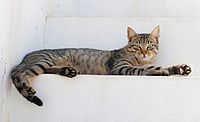
Photo from wikipedia
ABSTRACT Carpets have been implicated in prolonged and reoccurring outbreaks of human noroviruses (HuNoV), the leading cause of acute gastroenteritis worldwide. Viral recovery from environmental surfaces, such as carpet, remains… Click to show full abstract
ABSTRACT Carpets have been implicated in prolonged and reoccurring outbreaks of human noroviruses (HuNoV), the leading cause of acute gastroenteritis worldwide. Viral recovery from environmental surfaces, such as carpet, remains undeveloped. Our aim was to determine survival of HuNoV surrogates on an understudied environmental surface, carpet. First, we measured the zeta potential and absorption capacity of wool and nylon carpet fibers, we then developed a minispin column elution (MSC) method, and lastly we characterized the survival of HuNoV surrogates, feline calicivirus (FCV) and murine norovirus (MNV), over 60 days under 30 and 70% relative humidity (RH) on two types of carpet and one glass surface. Carpet surface charge was negative between relevant pH values (i.e., pH 7 to 9). In addition, wool could absorb approximately two times more liquid than nylon. The percent recovery efficiency obtained by the MSC method ranged from 4.34 to 20.89% and from 30.71 to 54.14% for FCV and MNV on carpet fibers, respectively, after desiccation. Overall, elution buffer type did not significantly affect recovery. Infectious FCV or MNV survived between <1 and 15 or between 3 and 15 days, respectively. However, MNV survived longer under some conditions and at significantly (P < 0.05) higher titers compared to FCV. Albeit, surrogates followed similar survival trends, i.e., both survived longest on wool then nylon and glass, while 30% RH provided a more hospitable environment compared to 70% RH. Reverse transcription-quantitative PCR signals for both surrogates were detectable for the entire study, but FCV genomic copies experienced significantly higher reductions (<3.80 log10 copies) on all surfaces compared to MNV (<1.10 log10 copies). IMPORTANCE Human noroviruses (HuNoV) are the leading cause of acute gastroenteritis worldwide. Classical symptoms of illness include vomiting and diarrhea which could lead to severe dehydration and death. HuNoV are transmitted by the fecal-oral or vomitus-oral route via person-to-person contact, food, water, and/or environmental surfaces. Published laboratory-controlled studies have documented the environmental stability of HuNoV on hard surfaces, but there is limited laboratory-based evidence available about survival on soft surfaces, e.g., carpet and upholstered furniture. Several epidemiological reports have suggested soft surfaces may be HuNoV fomites illustrating the importance of conducting a survival study. The three objectives of our research were to demonstrate techniques to characterize soft surfaces, develop a viral elution method for carpet, and characterize the survival of HuNoV surrogates on carpet. These results can be used to improve microbial risk assessments, the development of much-needed soft surface disinfectant, and standardizing protocols for future soft surface studies.
Journal Title: Applied and Environmental Microbiology
Year Published: 2017
Link to full text (if available)
Share on Social Media: Sign Up to like & get
recommendations!